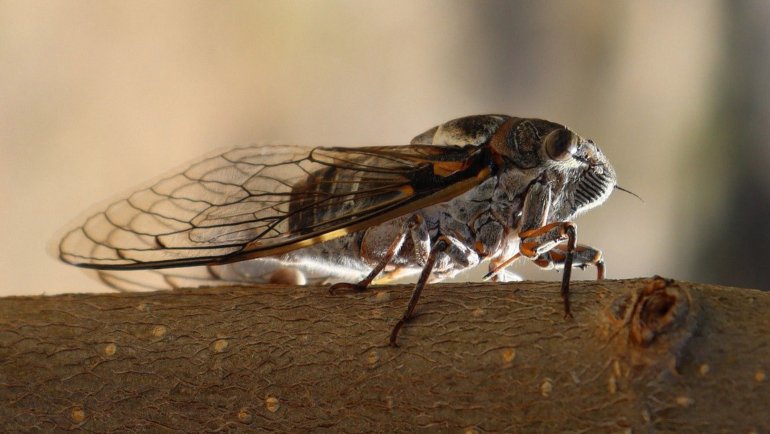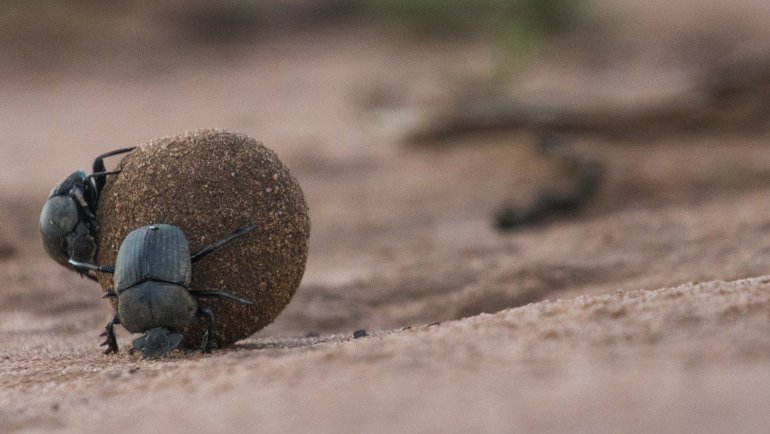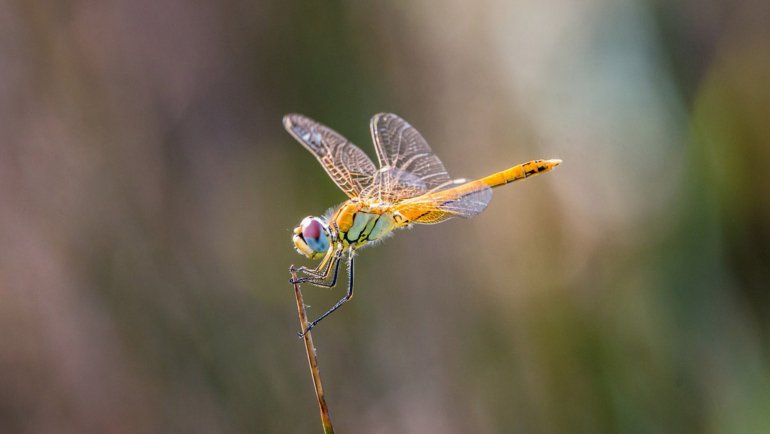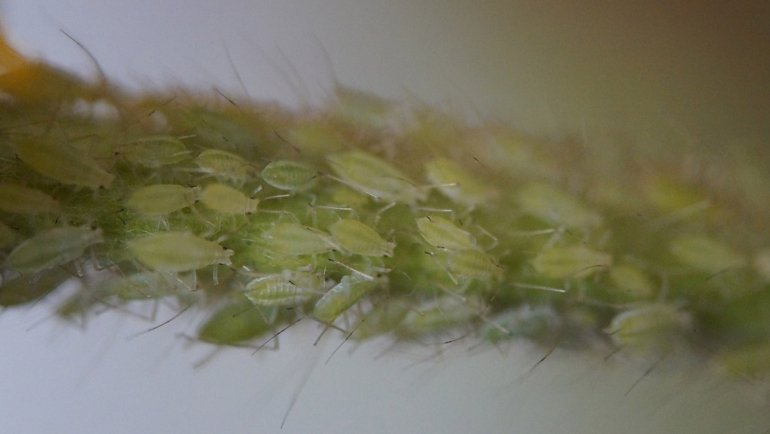Grasshoppers may seem like harmless insects hopping around fields, but in nature, they play a crucial role in the food chain. As a primary food source for a wide variety of predators, grasshoppers are targeted by birds, reptiles, mammals, amphibians, and even other insects.
Let’s explore the top predators of grasshoppers, their hunting tactics, and how grasshoppers defend themselves against these threats.
Top 8 Predators of Grasshoppers
1. Birds
Birds are among the most effective predators of grasshoppers. Many bird species rely on grasshoppers as a primary food source, especially during the breeding season when they need to feed their chicks. Insectivorous birds like sparrows, robins, starlings, and bluebirds actively hunt grasshoppers by scanning fields and grasslands.
- Hunting Tactics: Birds use their excellent vision to spot grasshoppers from a distance. They often swoop down from perches or fly low over fields to catch them.
- Notable Bird Predators:
- Eastern Bluebird (Sialia sialis) – Hunts grasshoppers to feed its young.
- American Kestrel (Falco sparverius) – A small falcon known for hovering in place before diving down to snatch grasshoppers.
- Cattle Egret (Bubulcus ibis) – Often seen following cattle to catch grasshoppers disturbed by their movement.
Interesting Fact: Some birds, like kestrels, have been observed storing grasshoppers in crevices for later consumption.
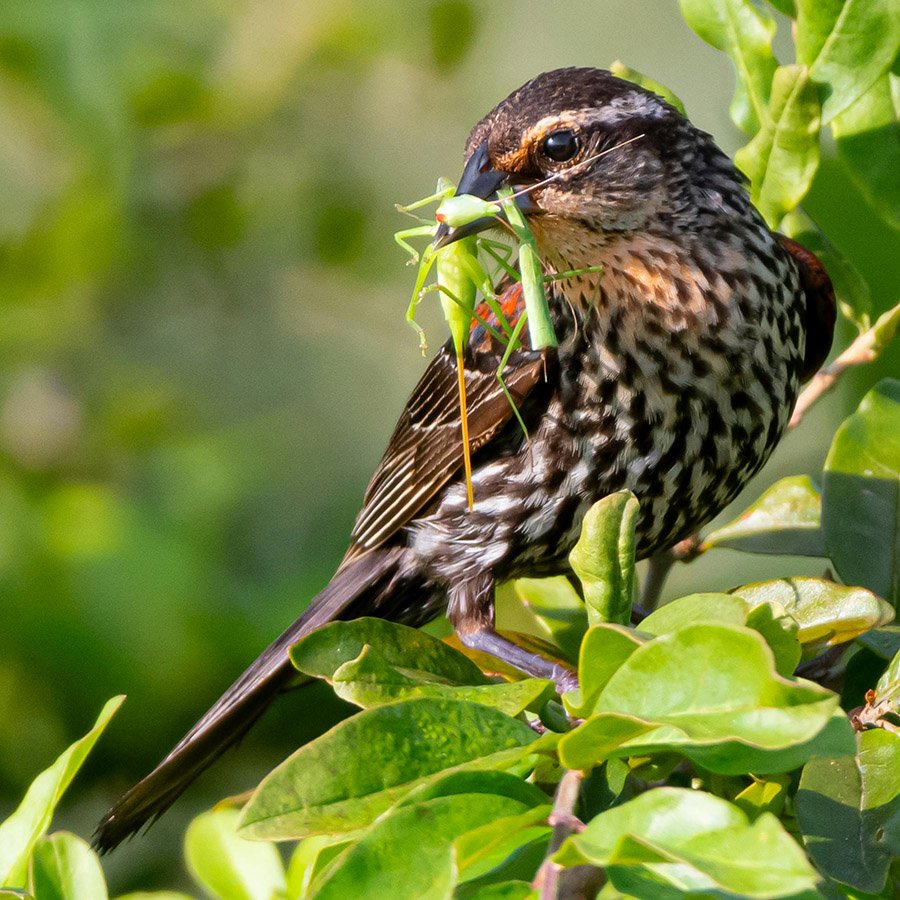
2. Reptiles
Lizards and snakes are opportunistic predators that prey on grasshoppers. Their stealth and quick reflexes make them highly effective hunters.
- Lizards: Lizards like geckos and chameleons actively hunt grasshoppers. Chameleons use their long, sticky tongues to capture prey from a distance, while geckos rely on their speed and agility.
- Snakes: Grasshoppers are a common snack for smaller, non-venomous snakes like garter snakes. These snakes often hunt in grassy areas where grasshoppers are abundant.
Interesting Fact: Chameleons can project their tongues up to twice the length of their bodies to catch grasshoppers.
3. Amphibians
Frogs, toads, and newts frequently hunt grasshoppers, especially in areas near water.
- Frogs and Toads: They use their sticky tongues to capture grasshoppers in a split second. Frogs rely on ambush tactics, waiting patiently for prey to come within range before striking.
- Newts: These amphibians hunt grasshoppers both on land and in water, depending on their habitat.
Interesting Fact: A frog’s tongue is not only sticky but also flexible, allowing it to wrap around prey for a secure grip.
4. Mammals
While most mammals are not primarily insectivorous, some small mammals eat grasshoppers as part of their diet, especially when other food sources are scarce.
- Hedgehogs: Known for their insect-heavy diet, hedgehogs munch on grasshoppers when foraging at night.
- Raccoons: Opportunistic feeders that will eat grasshoppers, especially if they are abundant in the area.
- Bats: Bats primarily eat flying insects, but some species consume grasshoppers when they are available. They use echolocation to locate grasshoppers and other insects in the dark. They swoop down and capture them in flight or pick them off vegetation. A single bat can eat thousands of insects, including grasshoppers, in one night.
- Grasshopper Mouse: This small rodent, native to North America, is unique in that it primarily feeds on insects, including grasshoppers. It is also known to howl like a miniature wolf to mark its territory.
Interesting Fact: The grasshopper mouse is immune to certain insect toxins, allowing it to safely consume venomous insects.
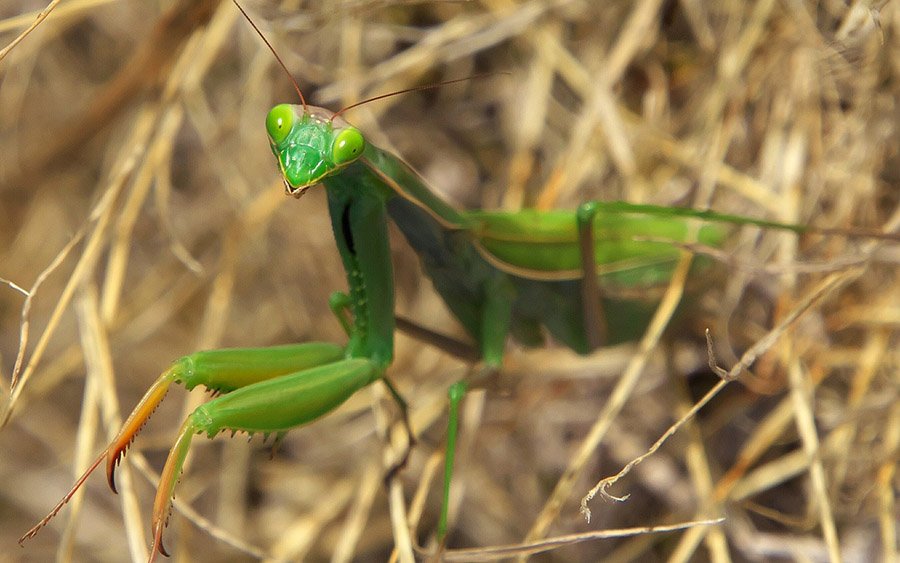
5. Insects
Some of the fiercest predators of grasshoppers are other insects. These include praying mantises, robber flies, and ground beetles.
- Praying Mantis: These stealthy hunters use their strong front legs to grab and hold onto grasshoppers while they eat them alive.
- Robber Flies: Known for their aggressive hunting style, robber flies catch grasshoppers in mid-air using their powerful jaws.
- Ground Beetles: These beetles are fast and often hunt grasshoppers at night, relying on their speed and strength to overpower them.
Interesting Fact: Some predatory insects, like assassin bugs, inject their prey with digestive enzymes before consuming them.
6. Spiders
Certain spiders, like wolf spiders, actively hunt grasshoppers, while others, like orb-weavers, catch them in their webs.
- Wolf Spiders: These spiders don’t use webs to catch prey. Instead, they rely on their speed and agility to chase down grasshoppers.
- Orb-Weaving Spiders: These spiders spin large webs that can trap unsuspecting grasshoppers. Once trapped, the spider wraps the grasshopper in silk before injecting venom.
Interesting Fact: Some spiders can sense the size and type of prey caught in their web based on the vibrations.
7. Fish
In areas near water, fish will eat grasshoppers that accidentally fall into the water. This happens frequently in ponds and lakes.
- Example: Bass and trout are known to eat grasshoppers that land on the water’s surface.
Interesting Fact: Fly fishers often use grasshopper-shaped lures to catch fish.
8. Humans
In some cultures, grasshoppers are considered a delicacy and are harvested as a food source.
- Common Preparations: Grasshoppers are often roasted, fried, or ground into powder. They are rich in protein and are a sustainable food option.
Interesting Fact: In Mexico, roasted grasshoppers, known as chapulines, are a popular snack.

How Grasshoppers Defend Themselves
Despite being on the menu for many predators, grasshoppers have evolved various defense mechanisms to increase their chances of survival. Here are some fascinating ways these insects protect themselves:
Camouflage: Blending In with Their Environment
Grasshoppers are masters of disguise. Their coloration often matches their surroundings, such as grass, leaves, or soil. This camouflage makes it difficult for predators to spot them.
- Green Grasshoppers blend in with lush vegetation.
- Brown and Grey Grasshoppers mimic the appearance of dry grass or dirt.
Camouflage is particularly important for grasshoppers in open fields, where cover is limited. By remaining motionless, they can avoid detection from birds and other predators.
Powerful Hind Legs: Making a Quick Escape
One of the most iconic features of grasshoppers is their powerful hind legs, which allow them to jump incredible distances. In fact, grasshoppers can jump up to 20 times their body length in a single leap.
Jumping allows them to:
- Escape from ground-based predators like lizards and small mammals.
- Cover large distances quickly to reach safer areas.
Some species of grasshoppers combine jumping with flying, allowing them to evade predators in mid-air.
Flight: Escaping Through the Air
Many grasshopper species are capable of flight, which gives them an additional escape strategy. When a predator approaches, a grasshopper can take off and fly to a new location. Some species even use erratic flight patterns to confuse predators.
For example:
- Desert Locusts can travel long distances by flying, which helps them escape from areas where predators are common.
- Large Grasshoppers in tropical regions can fly higher and farther, avoiding birds and other aerial predators.
Toxicity: A Chemical Defense Against Predators
Certain grasshopper species have developed chemical defenses that make them less appealing to predators. These grasshoppers accumulate toxins from the plants they eat, making them toxic or unpalatable.
- Milkweed Grasshoppers in Africa feed on toxic plants, storing the toxins in their bodies to deter predators.
- Spur-Throated Grasshoppers can secrete a bitter-tasting fluid when threatened, discouraging predators from eating them.
This chemical defense is particularly effective against predators like birds, which quickly learn to avoid toxic grasshoppers.
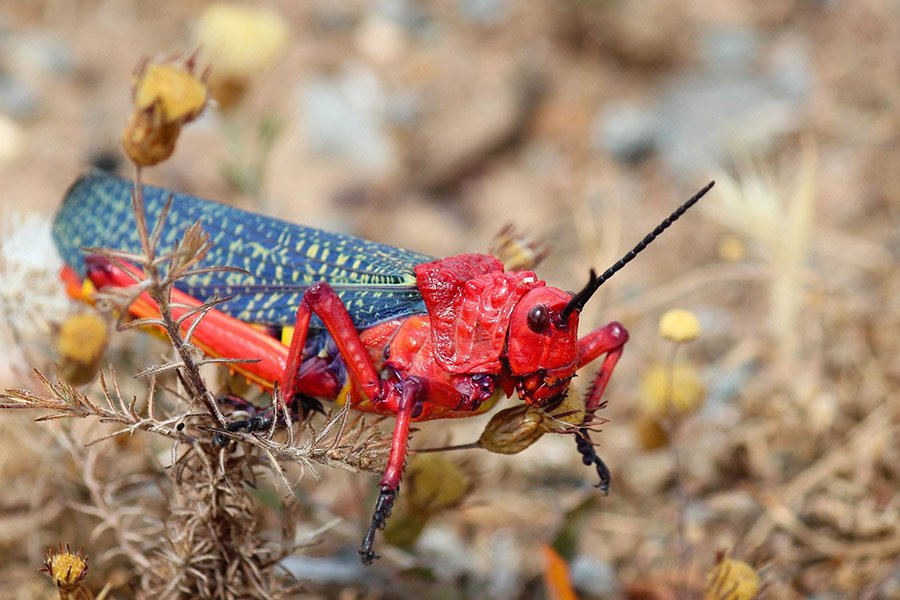
Warning Colors: A Visual Signal to Stay Away
Some grasshoppers use aposematic coloration (bright warning colors) to signal to predators that they are toxic or unpalatable. This strategy is similar to that used by poison dart frogs and monarch butterflies.
- Bright colors like red, orange, and yellow warn predators that the grasshopper may be toxic or dangerous to eat.
Example Species:
- Zonocerus variegatus (The Variegated Grasshopper) displays bright warning colors to signal toxicity to potential predators.
Defensive Behaviors: Startling or Confusing Predators
Grasshoppers may also employ startle displays to confuse predators. When resting, their wings may be hidden, but when threatened, they suddenly open their wings to reveal bright colors or eye-like patterns, startling the predator.
- Some grasshoppers will flick their hind legs at predators to defend themselves.
- Others may produce loud, buzzing noises when flying to disorient predators.
Conclusion: A Key Link in the Food Chain
Grasshoppers may not seem like the most exciting creatures at first glance, but their role in the food chain is essential. They provide nourishment for a wide variety of predators, from birds and reptiles to mammals and even humans. At the same time, grasshoppers have developed impressive defense mechanisms that help them avoid becoming an easy meal.
From camouflage to powerful jumps and even chemical defenses, grasshoppers are more than just simple insects—they are survivors. Their ability to adapt and defend themselves ensures that they continue to thrive in ecosystems around the world, maintaining balance in the natural world.
Understanding the predator-prey dynamics of grasshoppers gives us valuable insight into the delicate balance of ecosystems and the fascinating strategies animals use to survive.
